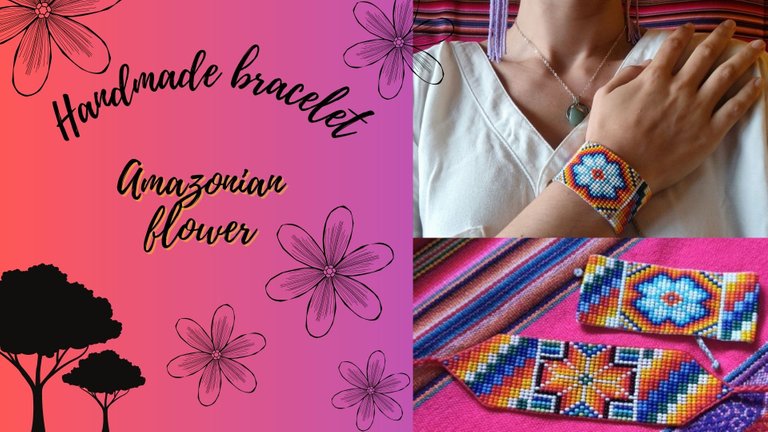

Hello everyone, I hope you are doing great. Today I would love to share with you the process of creating this flower bracelet. A couple of days ago I read a post from the jewerly community. Of the user @irenenavarroart was their participation in an initiative they had created for the month of women, the theme "Flowers".
If you have ever read any of my loom weaving posts you will surely know that I weave as a hobby, one that I have particularly given myself the task of developing with great delicacy in order to enjoy the processes that have arisen while I discover my ways of creating designs.
When I think of flowers I see beauty, I see the perfection that Mother Nature shows us through them, and at the same time I think of all the women who for some reason in my heart have become flowers in my family tree, my grandmother, my great-grandmother, my ancestors. I honor them, and it has not always been so, this began when I met one flower in particular. Chejeru.
Hola a todos, espero estén de maravillas. El día de hoy me encantaría compartirles el proceso de creación de este brazalete florido. Hace un par de días leí un post de la comunidad de jewerly del usuario @irenenavarroart era su participación para una iniciativa que habían creado para el mes de la mujer, la temática "Flores".
Si alguna vez has leído alguno de mis post de tejido con telar seguro sabrás que tejo por hobby, uno que particularmente me he dado la tarea de desarrollar con mucha delicadeza para poder disfrutar de los procesos que han podido surgir mientras descubro mis formas de crear diseños.
Cuando pienso en flores veo bellleza, veo la perfección que nos muestra la madre naturaleza a través de ellas, y a la vez pienso en todas la mujeres que por alguna razón en mi corazón se han convertido en flores de mi árbol genealógico, mi abuela, mi bisabuela, mis ancestras. A ellas las honro, y no siempre ha sido así, esto comenzó cuando conocí una flor en particular. Chejeru.
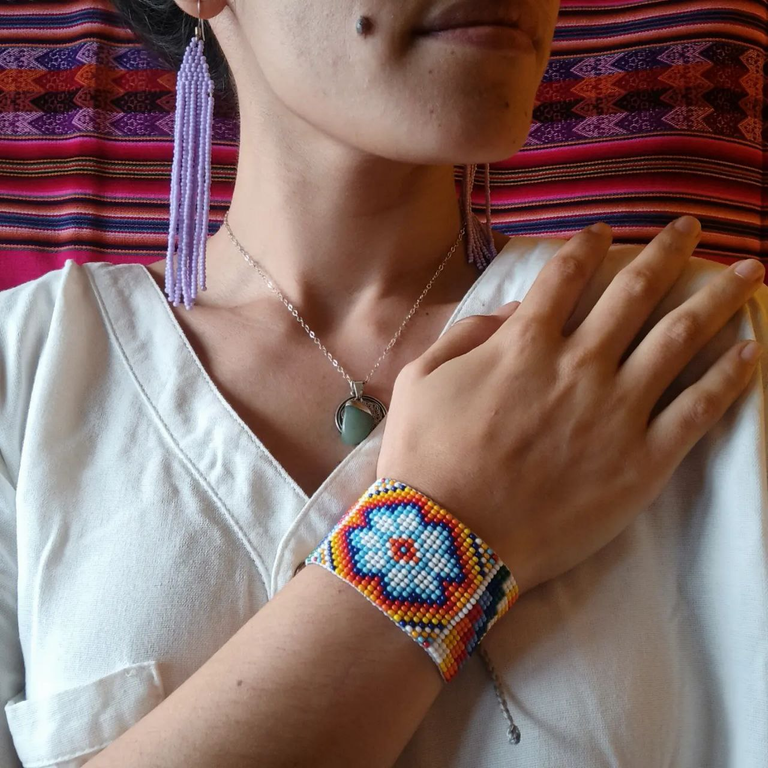
Chejeru for the Piaroa culture is the mother of medicines, she is the one who sowed the sacred medicine around the world. She is the goddess that is found in the flower that I am weaving today, the flower of the bejuco of the caapi plant Thanks to this flower I was able to connect with the strength of my mother and the women in my system.
And at this moment you may be wondering how is it that a flower can make you connect with something as powerful as your lineage? Well simple and without logic, this flower takes you to know yourself from the deepest part of your being, and when you get there the only thing you have left is to recognize yourself as part of the whole, recognize yourself and then thank all that which is before you.
That is why among the many flowers that exist, today I weave the caapi flower, the flower of absolute love.
Chejeru para la cultura piaroa es la madre de las medicinas, es la que sembró la medicina sagrada al rededor del mundo. Es la diosa que se encuentra en la flor que hoy estoy tejiendo, la flor del bejuco de la planta caapi. Gracias a esta flor es que pude conectar con la fuerza de mi madre y de las mujeres de mi sistema.
Y en este momento te podrás estar preguntando ¿cómo es que una flor puede hacerte conectar con algo tan poderoso como lo es tu linaje? Bueno sencillo y sin lógica, esta flor te lleva a conocerte desde lo más profundo de tu ser, y cuando llegas ahí lo único que te queda es reconocerte como parte del todo, reconocerte y luego agradecer a todo eso que te antecede.
Por eso entre las muchas flores que existen, hoy tejo la flor del caapi, la flor del amor absoluto.
Materials | Materiales
- Loom
- Nylon thread 060 gray color
- Czech mustard nº10
- Scissors
- Jeweler's tweezers
- Telar
- Hilo Nylon 060 color gris
- Mostacilla Checa nº10
- Tijeras
- Pinzas de joyero
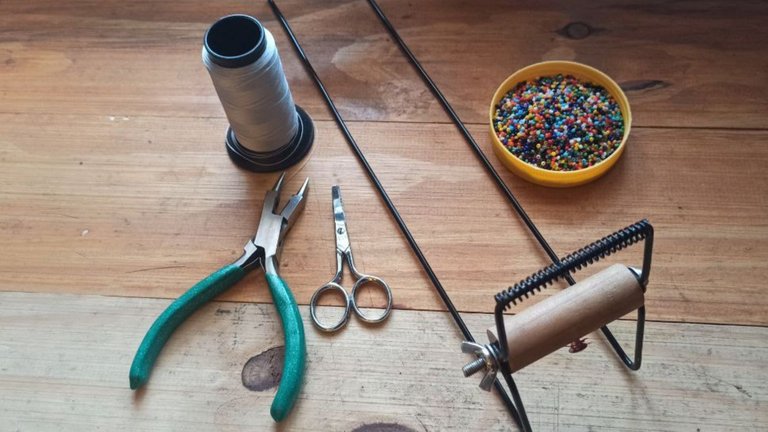
The first thing to do is to decide how many rows you want in the design, this design is 21 rows, so when assembling the loom I always place one more row of thread, that is 22.
Lo primero del tejido es decidir cuantas líneas quieres en el diseño, este diseño es de 21 líneas por lo que al montar el telar coloco siempre una línea más de hilo, es decir 22.
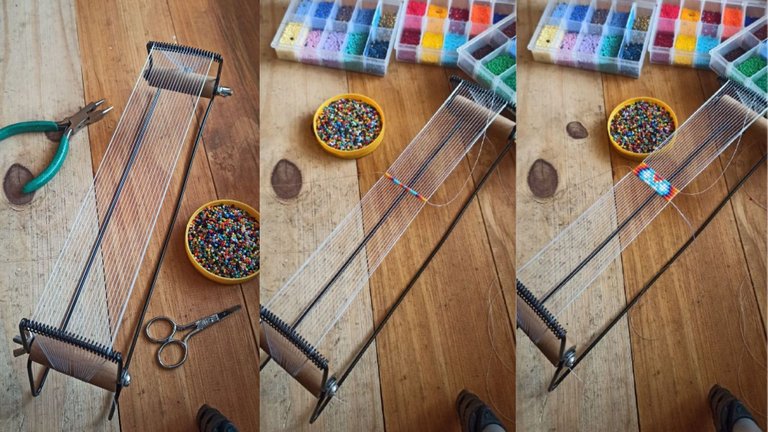
The first line can be the most difficult to assemble, it must be aligned, firm but not too tense and at the same time I have learned that the best way is that both threads pass from the bottom to the top, first one that fixes the beads and then another one that secures them. With this what I have left is to shorten the end of the bracelet so that the threads are not too tight and at the same time so that the weave is uniform at the ends.
Some people usually weave from the right to the left end, for me the easiest way is to start from the center, so I take the thread to the middle and leave it there, one half to weave the whole right side and then one half to weave the whole left side.
La primera línea puede ser la más difícil de montar, debe estar alineada, firme pero no muy tensa y a la vez yo por comodidad he aprendido que lo mejor es que ambos hilos pasen de abajo hacia arriba, primero uno que fija las mostacillas y luego otro que asegura las mismas. Con esto lo que me queda es achicar el final del brazalete para que no se tensen demasiado los hilos y a la vez para que el tejido quede uniforme en los extremos.
Algunas personas suelen tejer desde el extremo derecho al izquierdo, para mí lo más fácil es comenzar desde el centro, por lo que el hilo lo llevo hasta la mitad y lo dejo ahí, una mitad para tejer todo el lado derecho y luego una mitad para tejer todo el lado izquierdo.
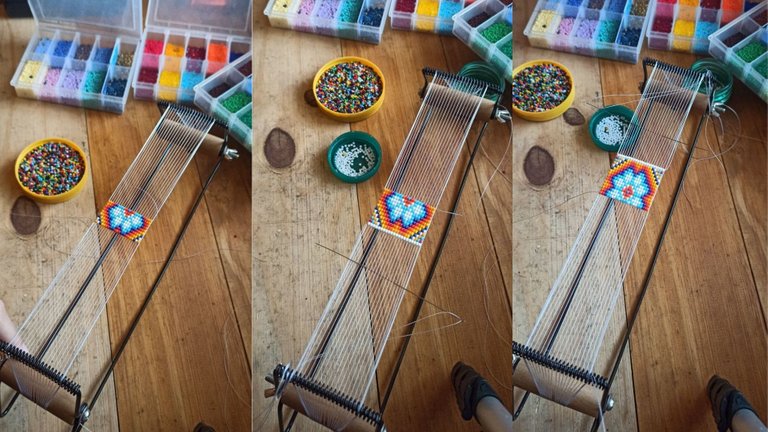
The colors of the indigenous people Wotujja or Piaroa as I named it at the beginning, are the colors Blue and White; For that simple reason I painted the flower of those colors, in the center I put red, since I identify myself with it and at the ends a gradient of the same red to make it stand out.
I started making first one half of the flower, when I reached its limit I turned the loom and wove the side that completed it, so as not to confuse me later and for practicality reasons because I just wanted this bracelet to be composed of two different designs, in the center the flower and outside a wiphala flag.
Los colores del pueblo indigena Wotujja o Piaroa como lo nombre al principio, son los colores Azul y Blanco; Por esa sencilla razón pinte la flor de esos colores, en el centro puse rojo, ya que me identifico con el mismo y a los extremos un degradado del mismo rojo para hacer que resaltara.
Comencé haciendo primero una mitad de la flor, cuando llegue a su límite le di vuelta al telar y tejí el lado que la completaba, así para no confundirme más adelante y por cuestiones de practicidad porque justo quería que esta pulsera se compusiera de dos diseños distintos, en el centro la flor y afuera una bandera Wiphala
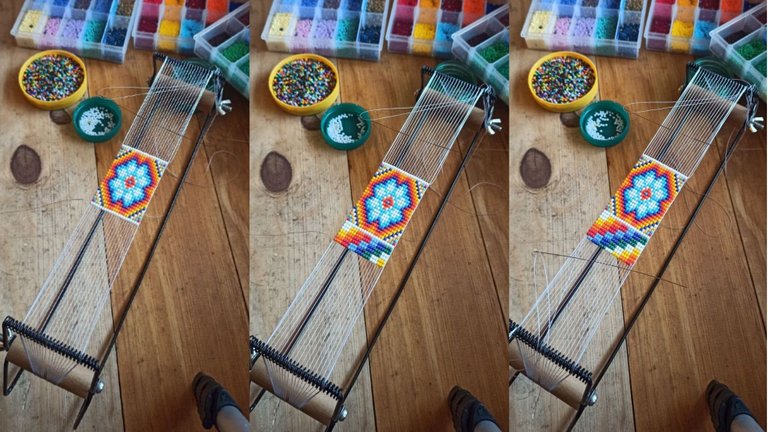
The Wiphala is a symbol of unification of the indigenous peoples of Andean origin. Countries like Bolivia hoist it with a clear intention reflected in its constitution and each of its colors has meaning and thus describe them:
RED: represents the planet earth, referring to the cosmic philosophy in the thought and knowledge of the wise, it is all the visible material world.
ORANGE: represents society and culture, it also symbolizes the conservation and procreation of the human species, it is health and medicine, training and education, cultural practice of dynamic youth.
YELLOW: represents energy and strength, reciprocity and complementarity, it is the expression of the moral principles of man, it is the laws and norms, the practice of human solidarity.
La Wiphala es un símbolo de unificación de los pueblos indígenas de origen andino. Países como Bolivia la izan con una intención clara reflejada en su constitución y cada uno de sus colores tiene significado y así los describen:
ROJO: representa al planeta tierra, haciendo referencia a la filosofía cósmica en el pensamiento y conocimiento de los sabios, es todo el mundo material visible.
NARANJA: representa la sociedad y la cultura, también simboliza la conservación y procreación de la especie humana, es la salud y la medicina, la formación y la educación, la práctica cultural de la juventud dinámica.
AMARILLO: representa la energía y la fuerza, la reciprocidad y complementariedad, es la expresión de los principios morales del hombre, son las leyes y normas, la práctica de solidaridad humana.
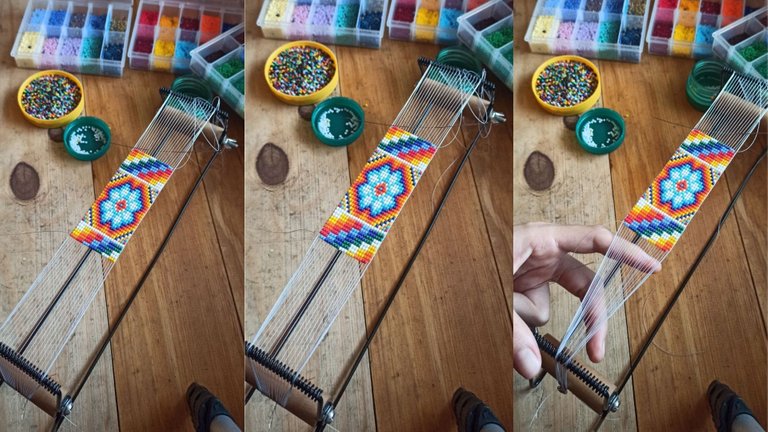
WHITE: represents: cyclical history, the development of science and technology, art, intellectual and manual work that generates reciprocity and harmony within the community structure.
GREEN: is the economy and production, symbolizes the natural wealth, flora and fauna, hydrological and mineral resources to the land and territory.
BLUE: represents space, cosmic energy, infinity, the spirit that animates everything.
VIOLET: represents politics and social and community ideology, the State, as a superior instance, the power structure, the social, economic and cultural organizations and the administration of the people and the nation.
BLANCO: representa: la historia cíclica, es el desarrollo de la ciencia y la tecnología, el arte, el trabajo intelectual y manual que genera la reciprocidad y armonía dentro de la estructura comunitaria.
VERDE: es la economía y la producción, simboliza las riquezas naturales, la flora y la fauna, los recursos hidrológicos y minerales a la tierra y al territorio.
AZUL: representa al espacio, la energía cósmica, al infinito, al espíritu que anima todo.
VIOLETA: representa a la política y la ideología social y comunitaria, al Estado, como una instancia superior, la estructura de poder, las organizaciones sociales, económicas y culturales y la administración del pueblo y la nación.

Finally the closing, this is the most important part, since it is very easy that everything gets messed up while you have to untension the loom, this is why very little by little and thread by thread, you have to close the threads from the ends as you are untensioning everything. At the same time you have to fix the beads and two by two you have to subtract beads to close it in the form of a funnel, which in my opinion is the strongest and safest way to close it.
Por último el cierre, esta es la parte más importante, ya que es muy fácil que todo se desordene mientras tienes que destensar el telar, por esto es que muy poco a poco y hilo por hilo, se tienen que ir cerrando los hilos desde los extremos a medida de que se va destensando todo. A la vez hay que ir fijando las mostacillas y de dos en dos ir restando mostacillas para darle cierre en forma de embudo, que a mi parecer es la forma de cierre mas fuerte y segura.
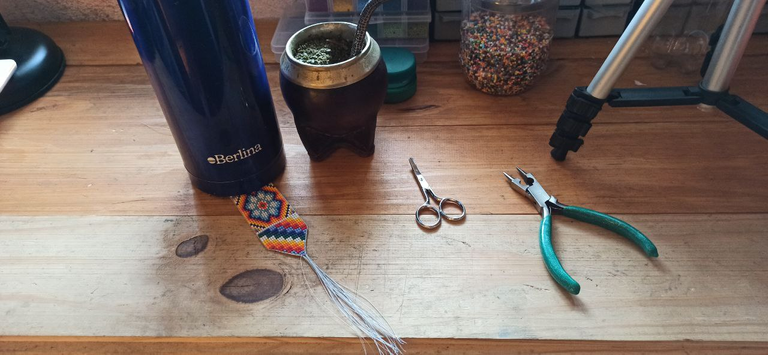
When I finished placing the last mustard, I cut the threads and weave a simple braid as long as I can and then close it with a simple knot. There are those who in this step place a special ornament closure or simply burn the end of the braid, I really like it with a knot, besides I know with certainty that this way it will never come undone or unravel.
Cuando acabé de colocar la última mostacilla, corto los hilos y tejo una trenza simple lo más larga que pueda para luego cerrar con un nudo simple. Hay quienes en este paso le colocan algún cierre especial de adorno o simplemente queman la punta de la trenza, yo la verdad que con un nudo me gusta, además que sé con certeza que así jamás se va a zafar o deshacer.
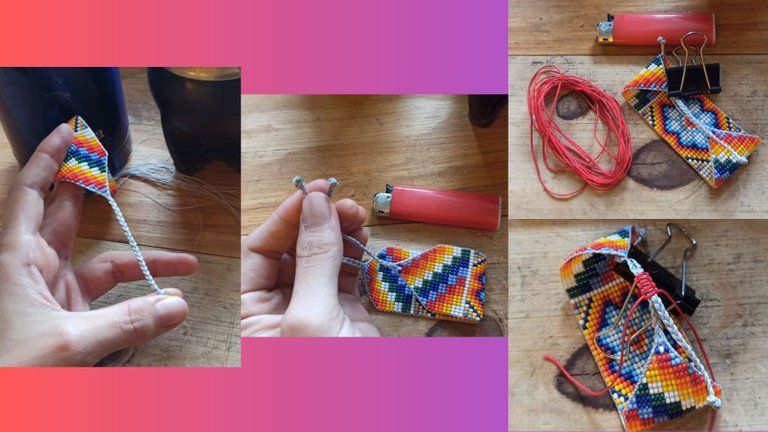
Normally these bracelets are made with a meaning, with an intention and with a prayer, for that reason they are made to be worn permanently. That is part of a belief, but really there are many people who prefer to wear them for special occasions and this one in particular while I was weaving it I thought of it as a gift for a good friend who has a birthday next week, she is a teacher and sometimes she has to take it off for practicality, so to finish the work I wove a slip knot made with macramé technique, this so that it would not be complicated when she wanted to take it off.
Normalmete estos brazaletes son hechos con un significado, con una intención y con un rezo, por esa razón son hechos para llevarse puestos de forma permanente. Eso es parte de una creencia, pero realmente hay muchas personas que los prefieren usar para ocasiones especiales y este en particular mientras lo tejía pensé en que fuera un regalo para una buena amiga que cumple años la próxima semana, ella es maestra y en ocasiones debe por practicidad retirársela, por eso para culminar el trabajo tejí un nudo corredizo hecho con técnica de macramé, esto para que no se le complicara cuando quisiera quitársela.
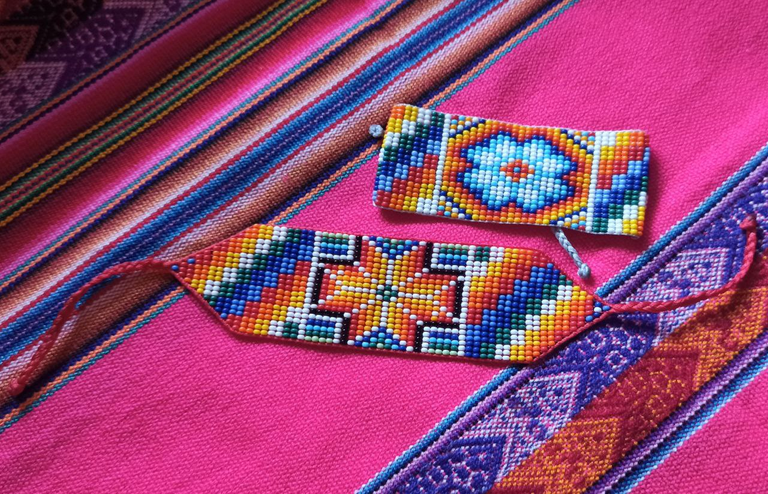
And that's how it turned out. With some motivation and a lot of desire to continue knitting, I made a sister, this time with a star in the center that many represent in the same way, so this was the result.
Y así quedo. Con algo de motivación y muchas ganas de seguir tejiendo, hice una hermana, esta vez con una estrella en el centro que muchos representan de la misma forma, así que este fue el resultado.
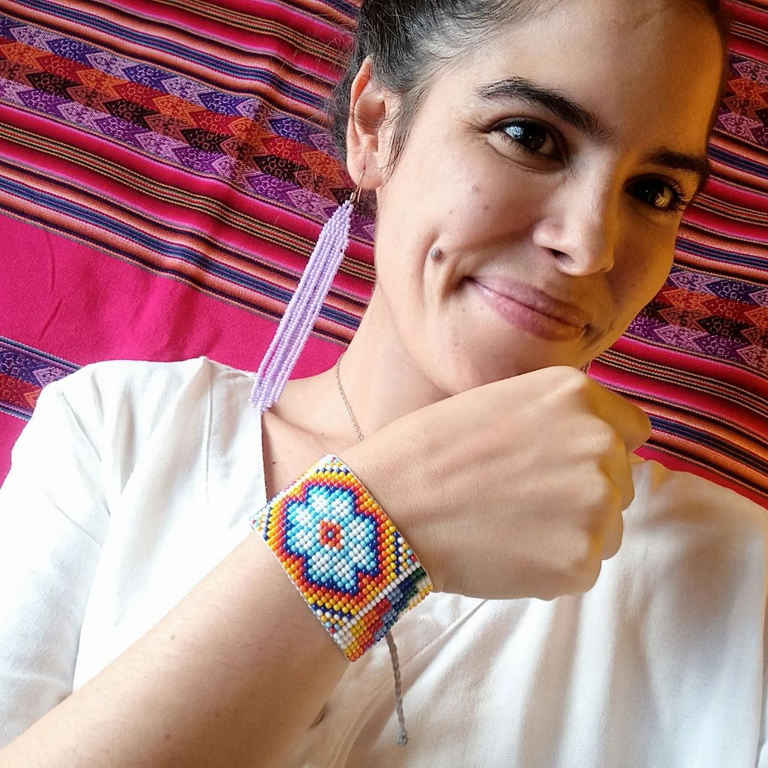
This has been my participation for this initiative, I hope you liked it. I wish you all the love in the world in this life, with much love and respect I say goodbye until next time.
Esta ha sido mi participación para esta iniciativa, espero les haya gustado. Les deseo todo el amor del mundo en esta vida, con mucho cariño y respeto me despido hasta la próxima.

